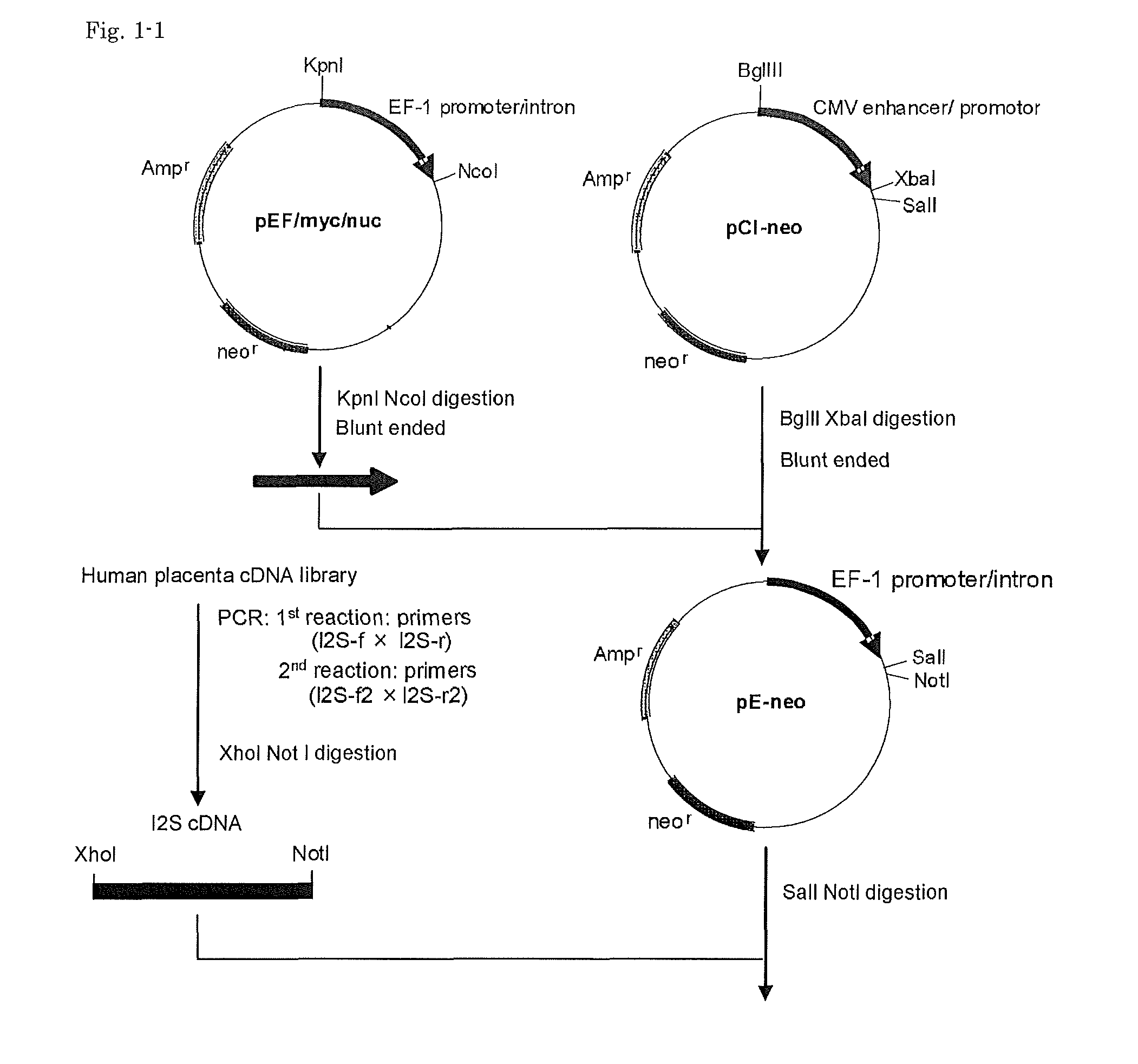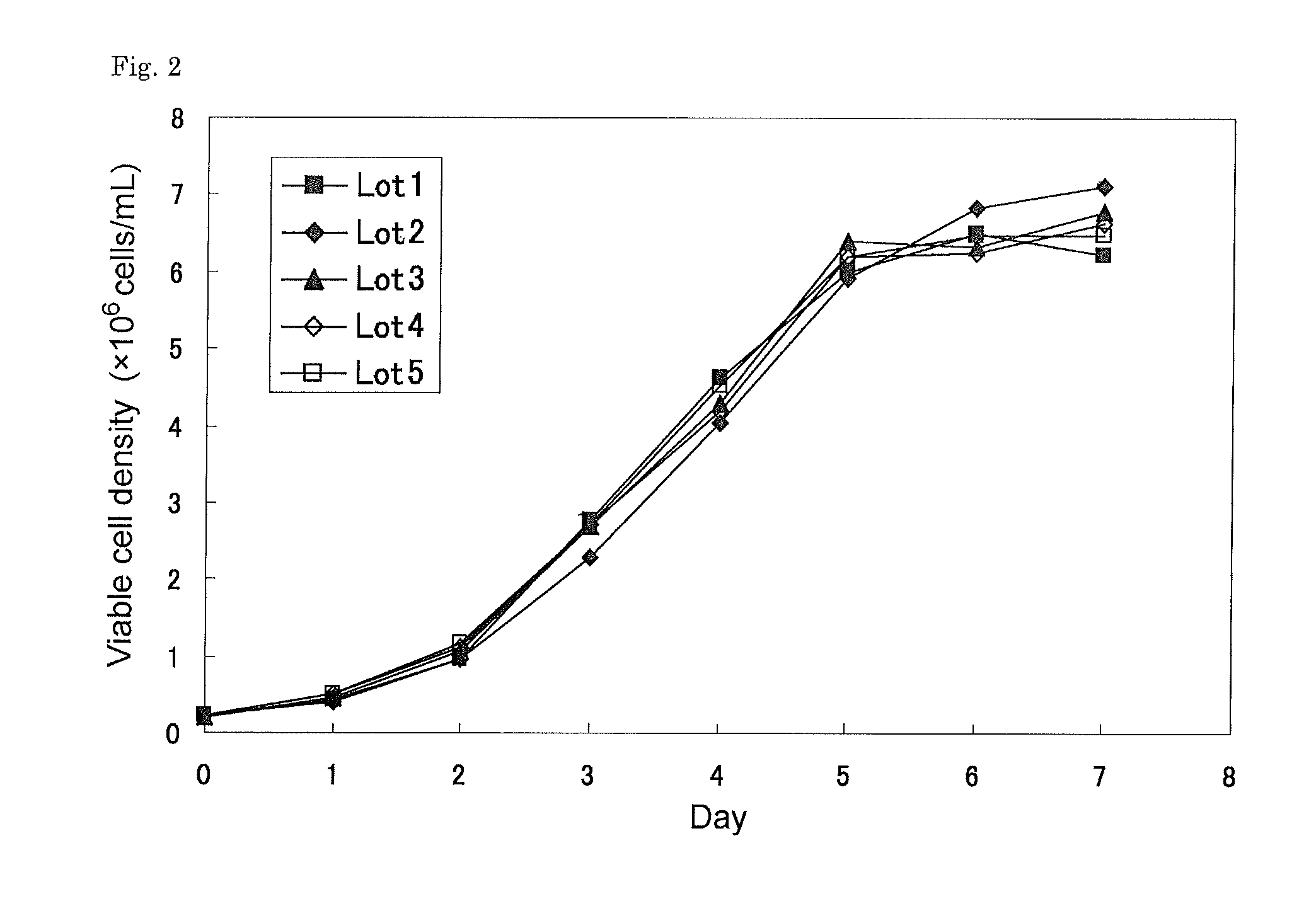Method for production of recombinant human iduronate 2-sulfatase
a technology of human iduronate and sulfatase, which is applied in the direction of enzyme stabilisation, drug composition, metabolic disorder, etc., can solve the problems of fragment accumulation, limited practical application of i2s replacement therapy, and inability to bind to i2s, so as to eliminate the risk of denaturation and avoid the use of organic solvents
- Summary
- Abstract
- Description
- Claims
- Application Information
AI Technical Summary
Benefits of technology
Problems solved by technology
Method used
Image
Examples
example 1
1. Construction of Human I2S Expression Vector
[0101]Vector pEF / myc / nuc (Invitrogen) was digested with KpnI and NcoI to cut out a region including the EF-1(alpha) promoter and its first intron, which then was blunt-ended with T4 DNA polymerase. Vector pC1-neo (Invitrogen) was digested with BglII and XbaI to cut out a region including the CMV enhancer / promoter and the chimeric intron, which then was blunt-ended with T4 DNA polymerase. Into this was inserted the above-mentioned region including the EF-1(alpha) promoter and its first intron to give pE-neo vector (FIG. 1).
[0102]Using a human placenta cDNA library (Takara Bio) as a template, a nested PCR reaction was performed with two sets of primers, composed of a set of outer primers:
[0103]
(a) I2S-f:(SEQ ID NO: 1)5′-ACGCCTATTGCTGCAGGATG-3′,and(b) I2S-r:(SEQ ID NO: 2)5′-AAACGACCAGCTCTAACTCC-3′
for the 1st reaction, and a set of two inner primers:
[0104]
(c) I2S-f2:(SEQ ID NO: 3)5′-ATActcgagGCCACCATGCCGCCACCCCGG-3′,and(d) I2S-r2:(SEQ ID NO:...
example 2
2. Production of Recombinant Cells for Expression of Human I2S
[0108]CHO cells (CHO-K1: purchased from American Type Culture Collection) was transfected with the above-mentioned expression vector pE-neo / hGHpA(I2S) using Lipofectamine2000 (Invitrogen) according to the following method. Briefly, on the day before transfection, 1×106 CHO-K1 cells were seeded in a 3.5-cm culture dish containing 3 mL of D-MEM / F12 medium containing 5% FCS (D-MEM / F12 / 5% FCS), and the cells were cultured overnight at 37 deg C in a humidified atmosphere of 5% CO2 and 95% air. On the following day, the cells were transfected with 300 microliters of a 1:1 mixture solution consisting of Lipofectamine 2000 solution diluted 25 times with Opti-MEM I medium (Invitrogen) and a plasmid DNA solution pE-neo / hGHpA(I2S) diluted with Opti-MEM I medium to 13.2 micrograms / mL, at 37 deg C in a humidified atmosphere of 5% CO2 and 95% air over night.
[0109]After transfection, the medium was replaced with D-MEM / F12 / 5% FCS supplem...
example 3
3. Culture of Recombinant Cells for Expression of Human I2S
[0112]The above seed cells were thawed and diluted to a cell density of 4×105 cells / mL and cultured for 3 to 4 days in IS CHO-V-GS medium supplemented with 8 mM of L-glutamine, 100 micromoles / L of hypoxanthine, 16 micromoles / L of thymidine (IS medium), and then diluted to a cell density of 2×105 cells / mL with IS medium and cultured for 3 to 4 days. The cells were again diluted to a cell density of 2×105 cells / mL and subjected to expansion culture which was performed by static-culture for 4 days at 37 deg C in a humidified atmosphere of 5% CO2 and 95% air.
[0113]The number of the cells was counted, and the cell culture was diluted with IS medium to a cell density of 5×105 cells / mL. 10 mL of CDLC (Chemically defined Lipid Concentrate, Invitrogen) was added to 1 L of the diluted culture and then the cells were shake-cultured for 3 days. The culture conditions for this were as follows: shaking speed: 20 rpm, pH 7.2, dissolved oxy...
PUM
| Property | Measurement | Unit |
|---|---|---|
| dissociation constant | aaaaa | aaaaa |
| dissociation constant | aaaaa | aaaaa |
| dissociation constant | aaaaa | aaaaa |
Abstract
Description
Claims
Application Information
 Login to View More
Login to View More - R&D
- Intellectual Property
- Life Sciences
- Materials
- Tech Scout
- Unparalleled Data Quality
- Higher Quality Content
- 60% Fewer Hallucinations
Browse by: Latest US Patents, China's latest patents, Technical Efficacy Thesaurus, Application Domain, Technology Topic, Popular Technical Reports.
© 2025 PatSnap. All rights reserved.Legal|Privacy policy|Modern Slavery Act Transparency Statement|Sitemap|About US| Contact US: help@patsnap.com



